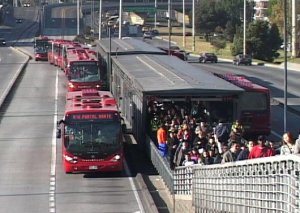Sheila Dikshit has surely got it wrong. What a pity, right at the beginning of her record-breaking third term as Delhi’s chief minister after a resounding victory in the state assembly polls, she took a ride along Delhi’s appallingly inefficient Bus Rapid Transit (BRT) System and declared it a success.
But she drove along it at midday when the traffic is light and there are few jams – I also went along the system on Christmas Eve and also found no problems. According to newspaper reports, she also broke the rules by driving down the bus lane, with all traffic lights turned to green.

Bogota's efficient BRT with wide 3-lane roads and passenger overbridges
But the idea of such a system is that it should function well at peak hours when traffic builds up. At such times, the BRT has been a clear disaster ever since it opened with crippling traffic jams, chaos, many accidents and deaths. Buses of course have generally speeded down their designated lanes, but have not proved successful in persuading people to switch from cars.
Apart from bus passengers, the main people who seem to have gained are the contractors and, presumably, officials in the Delhi government or one of the municipal agencies who must have got the kickbacks on the contracts.
(I have always wondered who the officials are who benefit from the frequently useless road equipment that it is regularly installed along the city’s roads – rubber flaps and mini-pylons marking lanes that quickly get snapped off by passing traffic, useless reflectors along central-reservation kerbs, roadside railings that are not needed, and now new street signs in Lutyens Delhi (and maybe elsewhere) that are twice as big as they need be).
The problem with the BRT is that the initial Ambedkar Nagar-Moolchand stretch was ill thought out and was the result, I suspect, of the battle that one of its advisers, Prof Dinesh Mohan of the Indian Institute of Technology, waged against the highly successful Delhi Metro train system.
He has persistently argued that the Metro is a waste of money because there are not enough trains and passengers, and pushed the BRT instead. The BRT was then rushed and introduced without a detailed study, as officials are now admitting publicly.
It was started on a stretch – from south of the Oberoi Hotel to the outer ring road – that was not even wide enough for existing traffic, and was inevitably far too narrow when regular traffic was restricted to two lanes. That view was endorsed by a parliamentary standard committee a few days before Dikshit endorsed the project after her ceremonial drive.
I can also vouch for it being too narrow and appallingly designed, having this summer seen a highly efficient BRT in Bogotá, the capital of Colombia, where I was visiting on holiday. There the roads are very wide and there are pedestrian bridges for bus passengers to cross the traffic lanes. The project is efficiently run by private sector contractors who built it and are responsible for collecting the fares and running the stations and bus services.
Nothing so well ordered has happened in Delhi, even though some officials visited Bogotá to study the system (on a presumably expenses paid trip). Here the roads are too narrow, there are no over bridges, and there is a total lack of safety – even Delhi officials are now admitting that three lanes in each direction for traffic are essential.
Now it is being reported that the system is to be extended, but with variations – what officials are reported to be calling “Flexi-BRT”. In some locations, the bus corridor will move from the centre of the highway to the left, and sometimes there will be a break and all the traffic will move together. That is surely a recipe for chaos at the junctions of the different layouts.
Having lived in India for many years, I admire how this country thrives on turning muddle and adversity into success. But what will happen when that muddle is designed, and is not the result of happenstance? Presumably, even greater muddle.
BRT can be appropriate when certain pre-requisites are in place. Delhi and Pune both fail in this respect. BRT is not an utopian model, it has its problems as I have described here http://better.pune.googlepages.com/WhyBRTinIndiadoesnotexciteme.htm
By: Joglekar on January 21, 2009
at 4:28 pm
We journalists thrive on outrage politician-phobia; I do myself. But in this case, heaping the blame on Sheila Dixit is right only in the sense that she could have stopped it. BRT was a pain, but only for the car owners of a fraction of south Delhi – perhaps 1% of Delhi’s population. Delhi’s roads are too narrow for dedicated lanes; but they are not too narrow for dedicated traffic. Traffic would move much better if some narrower roads were reserved for only buses or scooter rickshaws, and conversely if both were taken off some roads.
By: Ashok Desai on January 12, 2009
at 10:22 am
Dear John,
I must congratulate you for your brilliant analysis on Delhi’s BRT bus lane system. I feel Sheila Dixit’s government is suffering from the ill-effects of “Concorde Syndrome’ – an ailment where so much of public money was spent to develop a new idea (an aircraft). Towards the end of the development stage of the plane, one major justification used for pumping additional funds into the Concorde project was –since a lot of money had already gone down the drain, so more funds must be allocated to somehow make the aircraft a commercial success. Alas! it never happened ,and the consequences were disastrous-much to the dismay of Continental Europeans.
Mrs Dixit obstinacy in pursuing Delhi’s BRT defies rational thinking. Her recent electoral success was not a mandate on the ‘success’ of the BRT system. She would do well to reconsider further implementing this project, which since beginning was fraught with failure.
By: Ashwan Kapur on January 8, 2009
at 6:20 pm